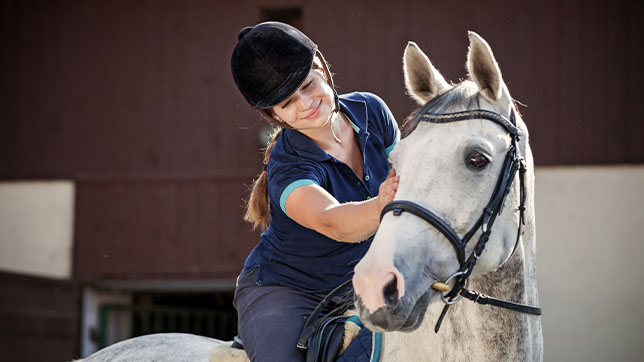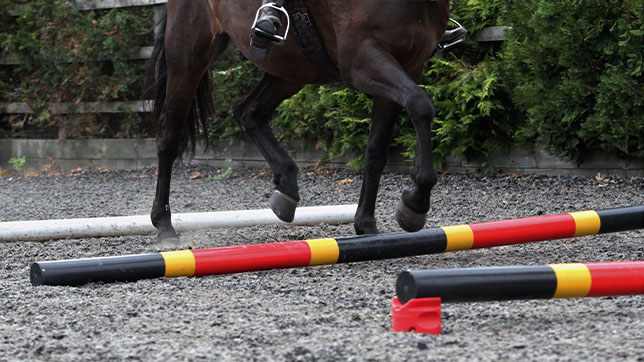14th February 2022
Horse exercise
If your horse lived in the wild, they’d likely travel around 20 miles every day!
It makes sense, therefore, to think about the amount of exercise they need to stay happy and healthy.
How much exercise does my horse need?
While working out your horse’s exercise routine, keep the following in mind:
- Your horse’s health – working through a fitness plan is ideal and horses who have suffered leg injuries, health conditions (like laminitis), or have needed box rest will have to be re-introduced to exercise slowly.
- Your horse’s diet – the right balance of fibre and energy will be needed to support your horse’s exercise routine; it’s always worth checking with a vet, or equine nutritionist, if you aren’t sure what to feed your horse!
- Your horse’s turnout situation – we know horses benefit from spending time in the field with their friends, though that isn’t always possible; so, upon your vet’s advice, consider providing plenty of space for them to exercise freely as part of their routine.
Remember: Riding a horse isn’t the only form of exercise they can enjoy, from lunging and long-reining to hacking in-hand or horse agility, there’s a suitable type of exercise for every equine.
Preparing for exercise
Once your horse’s diet has been taken care of, and they’re healthy enough to start working, it’s time to prep for exercise!
Steps to prepare for exercising your horse:
Step 1 – Check all tack is in safe condition and comfortable for your horse
An experienced saddler, or qualified saddle fitter, should be able to ensure your horse’s tack is properly fitted.
The Society of Master Saddlers’ Find a Member feature is useful if you’re searching for a registered, local saddler.
Step 2 – Groom your horse
By grooming your horse before exercising them, you can have a good look at their overall condition and will be able to notice if something’s not quite right.
Also, grooming your horse keeps their coat clean, which is essential when they’re wearing tack because dust and dirt can cause damage to their skin if trapped underneath the saddle, bridle, etc.
Plus, grooming is a great way to bond with your horse.
Step 3 – Get your safety gear sorted!
As a minimum, while exercising your horse you should wear a riding hat conforming to latest safety standards, a good pair of riding gloves, and a sturdy pair of riding boots.
If jumping a horse, it’s recommended riders wear a body protector that meets all relevant safety standards.
Additionally, you’ll need high-visibility wear for yourself (and your horse!) if hacking on roads and bridleways.
Local tack shops often offer free fitting when you purchase products from them, so it’s always worth checking your riding equipment is comfortable and safe.

Choosing the right type of exercise
Are you a dressage diva, super showjumper, or happiest while hacking?
Whichever activity you enjoy most with your equine friend, variety will prevent you both from getting bored!
Mixing up your horse’s exercise routine should suit your needs and theirs, whether it includes schooling sessions and hacking or clinics and competitions, the right routine looks different for every combination.
Let’s explore equestrian activities you might like to try with your horse…
Please note: If you have any concerns about your horse’s health, speak to your vet before embarking on any form of exercise with your equine friend.
Light ridden activities
Horses in light work are likely to enjoy more ‘rest days’ than those in harder work.
According to The British Horse Society (BHS), there are different levels of light work for horses:
- 1-3 hours per week, completed daily in 20-minute sessions.
- 3-7 hours per week, completed daily for around 35 minutes.
- 5-7 hours per week, completed daily with each session lasting 45-minutes.
Activities considered ‘light work’ for horses include:
- Hacking.
- Schooling.
- Showing.
- Low level dressage (British Dressage [BD] Intro, Novice, Elementary, Medium).
- Low level showjumping (British Showjumping Association [BSJA] Novice [90cm/2ft9], Discovery [1m/3ft3]).
- Riding clinics (group riding lessons, usually away from home!).
Medium level ridden activities
The BHS suggests that medium level activity for horses includes about 5-7 hours of work, split over 50-minute sessions, throughout the week.
Examples of medium level riding activities, in addition to light riding activities:
- Advanced+ dressage…
o British Dressage [BD] Advanced Medium.
o Prix St George.
o Intermediate I.
o Intermediate II.
o Grand Prix. - Newcomers+ show jumping…
o British Showjumping Association [BSJA] Newcomers [1.10m/3ft6].
o Foxhunter [1.20m/3ft9]. - Up to intermediate level eventing…
o British Eventing [BE] BE80 [Show Jumping =85cm/2ft9, Cross Country =80cm/2ft6].
o BE90 [SJ=95cm/3ft1, CC=90cm/3ft].
o BE100 [SJ=105cm/3ft4, CC=100cm/3ft3].
o BE100 Plus [Dressage=Novice level].
o BE105 [SJ=110cm/3ft6, CC=105cm/3ft4].
o Novice [SJ=115cm/3ft7, CC=110cm/3ft6].
High level ridden activities
For high level ridden activities, your horse should have completed a successful fitness programme and be happily able to cope with hard work.
The BHS suggests activities that are hard work for horses include:
- High level eventing…
o British Eventing [BE] Intermediate Novice [D=Intermediate level, SJ=120cm/3ft9].
o Intermediate [SJ=125cm/4ft1, CC=115cm/3ft7].
o Advanced Intermediate [D=Advanced level, SJ=130cm/4ft2].
o Advanced [SJ=130cm/4ft2].
o International [classes using the CCI code followed by 1* up to 5* for highest level horses and riders]. - Racing.
- Endurance rides (50 miles+).
To help you achieve your riding goals, you can use the BHS Find a coach service to discover the right riding instructor for you and your horse!
Non-ridden activities
Whether your children have outgrown their pony, your horse can’t yet be ridden because they’re too young, or you’re anxious about getting into the saddle, non-ridden activities can be an awesome alternative to riding!
Ponies who have been outgrown, and horses who hate being ridden (who don’t have health issues), may appreciate a new career in carriage driving. You can visit the British Carriagedriving site to discover more about the elegant yet exciting sport of carriage driving.
If you’d prefer ‘everyday’ exercise with your horse, you could try (while wearing a suitable riding hat, riding gloves, and riding boots, of course):
- Lunging – involves sending your horse to work on a large circle to improve their balance and ability to listen to your voice; lunging for 20 minutes is the equivalent to an hour of riding, so, if you add poles or jumps into your horse’s lunging session, they’ll be working really hard!
- Loose schooling – involves letting your horse move freely in a safe, enclosed space (like an arena); some owners prefer to test their horse’s agility by placing poles on the ground or setting up show jumps.
- Walking your horse – involves taking your horse for a walk in-hand (using either a bridle or headcollar and lead rope), which provides a brilliant opportunity to bond and have fun with your equine friend. If taking your horse for a walk on a road or bridleway, don’t forget your high-visibility kit.
Other ideas for non-ridden activities to enjoy with your horse:
- Horse agility – an equestrian discipline that’s increasing in popularity, horse agility allows you to have fun with your equine friend without a saddle in sight! To find out more about this interesting sport, visit the Horse Agility Club of Great Britain.
- In-hand showing – if you love the thrill of competition but can’t ride your horse, give in-hand showing a go; there are even online classes for horses who dislike travelling!
- Horse boarding – a comparatively new sport, perfect for the adrenaline junkies! A derivative of kite-boarding, participants are pulled at full gallop around a course on a 4-wheeled mountain board; protective gear advised!
Looking for more horse advice?
Support and advice so that owners and riders can take the very best care of their equine.
Need horse insurance?
Horse insurance can help cover the cost of veterinary treatment if your horse gets injured or falls ill.
We know pets
Our pets are part of the family. To achieve our vision of a better future for pets everywhere, we work with our partners, vets, and other veterinary professionals who are pioneering the latest advancements in animal care. Our campaigns, articles, and events are crafted to support, educate, and celebrate pet owners, while our policies are designed to provide peace of mind at an affordable price.
Yet our policies don’t just protect against the unexpected – they have purpose, too.
Since we were founded over 25 years ago, we've provided industry-leading policies that protect the nation’s pets, while also making a difference to animal welfare and our planet. Thanks to you, our policyholders, we've donated over £9 million to more than 830 animal welfare charities and conservancies, helping to support vulnerable pets and wildlife around the world.
We’re proud to be wildly different. Are you?

